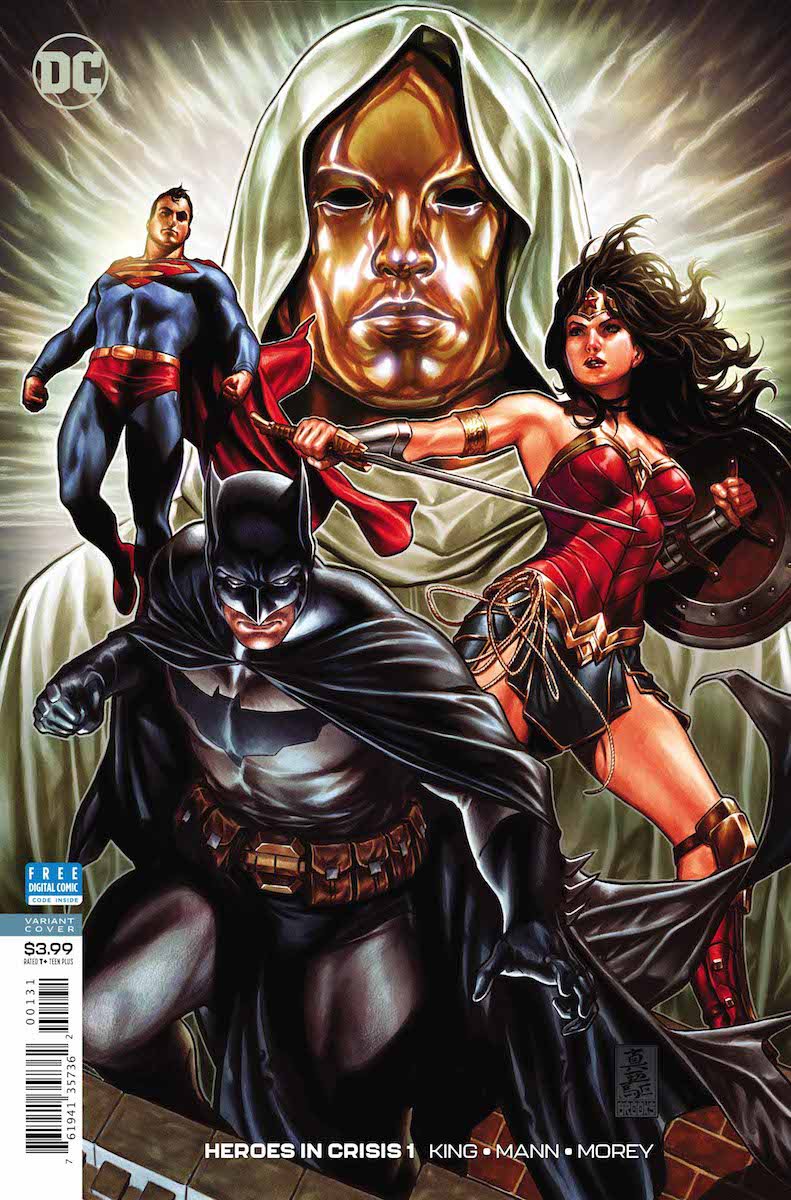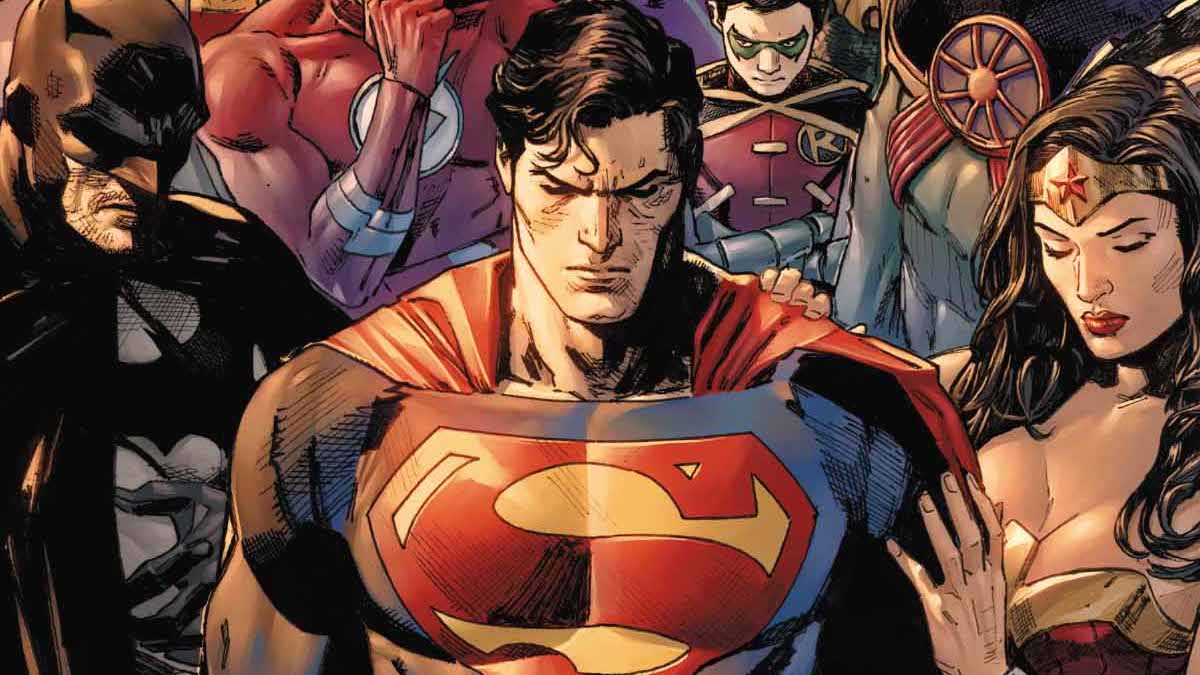
Heroes in Crisis #1 – Tom King, Writer; Clay Mann, Artist; Tomeu Morey, Colorist
Ray – 8/10
Corrina: An uneasy story combination
WARNING: SPOILERS BELOW
Ray: Tom King begins his biggest event in the DCU yet with Heroes in Crisis #1, stepping for the first time outside a self-contained book and turning his slow-burn theme of superhero mental health into a high-octane suspense thriller. The obvious parallel – a Superhero drama dealing with a murder mystery and dark secrets in the superhero community – is the controversial early-200s miniseries Identity Crisis, but this first issue thankfully eschews the gross rape plotline that made that miniseries a mainstream attention-getter for all the wrong reasons.
Heroes in Crisis #1 is definitely a better debut, but I’m still not sure it quite works. Tom King’s skill lies in the intimacy and tragedy of his stories. Books like Marvel’s Vision and DC’s Mister Miracle are him at the top of his game, while Batman has a lot going for it but still feels like it’s missing a step from those masterpieces. Heroes in Crisis feels another step from that intimate groove, bathing its personal dramas in a wave of death.
The issue takes place in two separate narratives – one featuring the trinity of Batman, Superman, and Wonder Woman. They’ve all been called separately to Sanctuary, the superhero mental health clinic that exists in the middle of nowhere. A small-town farmhouse monitored by a powerful psychologist AI, it seems deliberately modeled on Superman’s childhood in Kansas. But what the heroes find there isn’t a peaceful mental health clinic, it’s a massacre. The residents of Sanctuary, including its staff, have been massacred. The deaths include Jurgens-era Titan Hot Spot, Young Justice b-lister Lagoon Boy, and what seems to be a version of Commander Steel – as well as two A-listers, Arsenal, and the older Wally West. The former was telegraphed so hard no one could miss it, and the latter has already been spoiled as a fake-out by solicits, so these early deaths lack some impact. More disturbing is the vision inside the house and the mysterious message written over the bodies.
Then there’s the second plot, a showdown at a diner between the two survivors of the assault on Sanctuary – one a villain trying to turn over a new leaf, the other a hero who has fallen from grace. Booster Gold, the latter, is at a diner desperately trying to collect his thoughts when he gets an unwelcome visitor – Harley Quinn.
She’s convinced he killed everyone at Sanctuary, and he doesn’t remember or understand enough to tell her otherwise. This is an interesting fight scene, and probably the best part of the issue – it’s a battle wrapped in grief, confusion, and unraveling mental states. King couples the wide-screen action by Clay Mann with nine-panel grids showing the intake interviews of the patients at Sanctuary, and it’s interesting that Blue Jay – last seen in the Orlando JLoA run – is one of them when he doesn’t appear in the rest of the issue. Something’s being built here.
This is overall a very high-quality issue, but I’m not sure King’s style works as well with widescreen action as it does with intimate thrillers, and this series will need to become great to justify the senseless death it’s built around.

Corrina: When Heroes in Crisis was first announced, I thought it was a fascinating idea to explore a place like Sanctuary and how heroes can recover from trauma.
But then DC started advertising the event by providing odds on who would live and die. DC Comics even promoted Heroes in Crisis #1 on Twitter with a photo of Arsenal and asking the question of whether he’d recover from his slip back into drug addiction.
Because the best way to present a serious examination of mental illness is to promote it with a character who is senselessly murdered in the first issue. [Insert your favorite eye-roll/facepalm gif]
To me, this read exactly like Identity Crisis 2: Electric Boogaloo.
The ill-advised and gross rape plot has been swapped out for a larger body count, so that’s….good? Yay, no rape, but, instead, there’s a massacre at a mental health facility. That’ll show the audience we’re serious about examining real-world trauma and the effect on mental health, right everyone?
The most interesting pages are the intake interviews, spread out in the issue via nine-panel pages. But those interviews also raise a great number of questions.
If murderous people like Harley Quinn are allowed to be in Sanctuary, how can one guarantee the safety of the other patients? And why would Harley even agree to go to Sanctuary, given her own background as a trained psychologist? That fits with nothing that we know of the character, who’s comfortable being the doctor, not the patient. (And she tends to be hilariously good at that, sometimes, when her worst impulses don’t get the better of her.) Harley is a murderer, though mainly of bad people, but she doesn’t belong in the same place as, say, Blue Jay, who caused harm to no one.
The diner scene also makes no sense. There’s a massacre. Harley and Booster run away but the Trinity are investigating and somehow can’t find this pair at a diner that seems to be somewhat near the site of the crime? I can’t buy that for one second and nor do I buy their conversation, which seems less a conversation than a placeholder for what the writer, King, wants to say about superheroes and trauma.
In short, the concept is good, but the execution is counter to the book’s stated objectives, and the characters seem to exist only to spout philosophy. Or die.
There is a way to show a massacre like this and its impact on survivors and their loved ones. Shelter in Place by Nora Roberts comes to mind. That story, like this, begins with a massacre, a mass shooting at a mall, and follows the survivors and their loved ones over the next decade, showing how they cope (or fail to cope in some cases.) That story, which also includes a search for a hidden killer, is a fascinating examination of how people move forward from grief and loss.
Meanwhile, Heroes in Crisis #1 only gives us a body count, with a telegraphed ending that is only going to cause more trauma to the superhero community. It feels nihilistic, in much the same way Identity Crisis did.
To find reviews of all the DC issues, visit DC This Week.
Disclaimer: GeekDad received this comic for review purposes.




